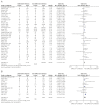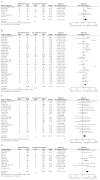The coronavirus disease 2019 infection in pregnancy and adverse pregnancy outcomes: a systematic review and meta-analysis
- PMID: 37194243
- PMCID: PMC10375217
- DOI: 10.5468/ogs.22323
The coronavirus disease 2019 infection in pregnancy and adverse pregnancy outcomes: a systematic review and meta-analysis
Erratum in
-
The coronavirus disease 2019 infection in pregnancy and adverse pregnancy outcomes: a systematic review and meta-analysis.Obstet Gynecol Sci. 2023 Nov;66(6):587. doi: 10.5468/ogs.22323.e1. Epub 2023 Nov 15. Obstet Gynecol Sci. 2023. PMID: 37985746 Free PMC article. No abstract available.
Abstract
The coronavirus disease 2019 (COVID-19) outbreak which started in December 2019 rapidly developed into a global health concern. Pregnant women are susceptible to respiratory infections and can experience adverse outcomes. This systematic review and meta-analysis compared pregnancy outcomes according to COVID-19 disease status. The MEDLINE, EMBASE, and Cochrane Library databases were searched for relevant articles published between December 1, 2019, and October 19, 2022. Main inclusion criterion was any population-based, cross-sectional, cohort, or case-control study that assessed pregnancy outcomes in women with or without laboratory-confirmed COVID-19. Sixty-nine studies including 1,606,543 pregnant women (39,716 [2.4%] diagnosed with COVID-19) were retrieved. COVID-19-infected pregnant women had a higher risk of preterm birth (odds ratio [OR], 1.59; 95% confidence interval [CI], 1.42-1.78), preeclampsia (OR, 1.41; 95% CI, 1.30-1.53), low birth weight (OR, 1.52; 95% CI, 1.30-1.79), cesarean delivery (OR, 1.20; 95% CI, 1.10-1.30), stillbirth (OR, 1.71; 95% CI, 1.39-2.10), fetal distress (OR, 2.49; 95% CI, 1.54-4.03), neonatal intensive care unit admission (OR, 2.33; 95% CI, 1.72-3.16), perinatal mortality (OR, 1.96; 95% CI, 1.15-3.34), and maternal mortality (OR, 6.15; 95% CI, 3.74-10.10). There were no significant differences in total miscarriage, preterm premature rupture of membranes, postpartum hemorrhage, cholestasis, or chorioamnionitis according to infection. This review demonstrates that COVID-19 infection during pregnancy can lead to adverse pregnancy outcomes. This information could aid researchers and clinicians in preparing for another pandemic caused by newly discovered respiratory viruses. The findings of this study may assist with evidence-based counseling and help clinicians manage pregnant women with COVID-19.
Keywords: Coronavirus disease 2019; Pregnancy complications; Pregnancy outcomes; Respiratory tract infections; Viral infection.
Conflict of interest statement
The authors declare that they have no competing interests.
Figures





References
-
- Khoury R, Bernstein PS, Debolt C, Stone J, Sutton DM, Simpson LL, et al. Characteristics and outcomes of 241 births to women with severe acute respiratory syndrome coronavirus 2 (SARS-CoV-2) infection at five New York City medical centers. Obstet Gynecol. 2020;136:273–82. - PubMed
-
- Melo GC, Araújo KCGM. COVID-19 infection in pregnant women, preterm delivery, birth weight, and vertical transmission: a systematic review and meta-analysis. Cad Saude Publica. 2020;36:e00087320. - PubMed
LinkOut - more resources
Full Text Sources

